COCKATOO'S
Cockatoo's
Temperament, Diet, Health care etc
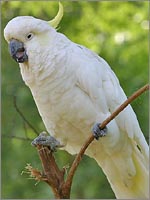
Size: 30 - 43 cm / 12 - 17 inches
Life Expectancy: 40 - 80 years
All About Cockatoos
The Cockatoos are one of the most favored birds as pets in the Parrot family. They are extremely attractive birds possessing striking talking abilities. Cockatoos are extremely beautiful, loving and social creatures, portraying an intelligent, playful, inquisitive and enchanting self.
Description of Cockatoos
Most Cockatoos are white in color, but others come in greys and pinks, blacks, and in the Palm's case, deep blue.
Types of Cockatoos
Below are a list of the most popular types of Cockatoos
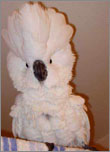
Umbrella Cockatoo
White or White-Crested Cockatoo or better known as the Umbrella Cockatoo. Umbrella Cockatoos are very intelligent, quite social, good natured, active, acrobatic and very affectionate
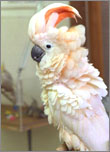
Moluccan Cockatoo
The Moluccan Cockatoo is the largest of the "white" cockatoos. The Moluccan Cockatoo is a very intelligent and a sensitive bird.
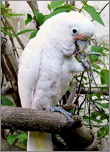
Goffin Cockatoo
The Goffin Cockatoo is a fun-loving parrot who is a born entertainer. The Goffin Cockatoo is a fair talker but some have been known to talk extensively.
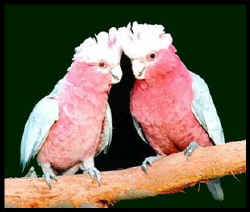
The Rose Breasted or more commonly know as The Galah Cockatoo
DESCRIPTION:
The general plumage of the Galah is dark pink. The forehead, the crown, the lores and the nape are whitish-pink. The back, the wings and the tail are grey. The lower abdomen, the vent area, the secondary-coverts, the rump and upper tail-coverts are whitish-grey. The eye ring is rose-red and the iris is dark brown. The feet of the Galah are grey and the bill is horn-coloured.
Other Names:
Rose-breasted Cockatoo, Roseate Cockatoo, Willock Cockatoo.
LIFE SPAN:
Living in captivity the Galah can become 70 to 80 years of age . In the wild the average Galah will not reach the age of twenty years. A pair of Galahs will bond for life and will be capable of breeding for up to 40 years. This meant that the offspring of one pair of Galahs became 120 birds after all their breeding years.
SIZE:
Length about 35 cm (14 "), weight about 300 to 400 grams
SEXING:
Female Galah resembles the male but the iris is red. The immature Galahs have a duller plumage. The iris in both sexes is brown. Their eye ring is grey, tinged with a little pink.
Temperament
The Galah can make an excellent pet, with even wild caught young birds capable of becoming affectionate and friendly birds. They will however often become a little unpredictable when mature, and should never be allowed to spend time on a shoulder.
They are extremely playful and intelligent birds, which, like most cockatoos, need constant stimulation with toys to play with, and objects to chew, to keep them from getting bored.
They are not generally noisy, apart from early morning and evening, although some are the exception to the rule. Both sexes can become good talkers, possibly with the males being somewhat better, however their talking ability is not usually on a par with either Sulphur-crested Cockatoos or the Corellas.Galahs are an extremely popular cage and companion parrot and the hand reared birds make affectionate companions and often will become proficient talkers. They are not as noisy as the larger Sulphur-crested Cockatoo.
DIET:
Their diet: striped sunflower, pumpkin seed, small seed mix (safflower, millet, hemp, oats,Canary mix, wheat,), pine and other nuts. They also need plenty of fruit and vegetables, especially apple and peas.Cooked pulses. Avocado is not to be fed to any parrot due to the harmful effect and possible death that may occur. Green food is always appreciated.A more advanced seed is now available at our shop,It is called Vesele Laga 'Loro Parc' Australian Parrot mix with Vam pellets,we always have this in stock.
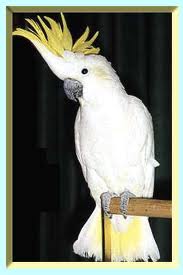
The Lesser Sulfa Crested Cockatoo
The Lesser Sulphur-crested Cockatoo, or Yellow-crested Cockatoo, Cacatua sulphurea, is endemic to Lombok, Sumbawa, Noesa Penida Island in Indonesia and East Timor in Southeast Asia. There is a feral population in Hong Kong. Thus large group has apparently developed from a number of caged birds that have been released over many years.
This cockatoo is critically endangered endangered in its natural habitat where numbers have declined dramatically due to illegal trapping for the cage-bird trade. The current feral population is estimated at less than 10,000. It is, therefore, listed on Appendix I of CITES.
Description:
The plumage of ths cockatoo is all white, except for its long, forward-curling yellow crest. It has a loud and very raucous voice.
Training and Behavioral Guidance:
Cockatoos certainly demand a lot of attention, but are appreciated for their exceptionally loving, devoted personality that is second to none. Cockatoos require an extremely dedicated owner who is willing to provide significant and meaningful attention to these intelligent parrots. They require consistent training from a young age to ensure potential cockatoo owners enjoy a bird free of destructive and annoying habits. Behavioral challenges that cockatoos present include:
- Excessive Chewing: Any parrot will chew. In nature, they use their beak to "customize" their favorite tree, to enlarge the size of their nest in a tree hollow. Doing this keeps their beaks in good condition. The problem is excessive and undesirable chewing. Undisciplined cockatoos will chew on electric wiring potentially causing house fires. The owner needs to provide plenty of "healthy" chewing opportunities (bird toys, natural wood branches, etc.) and training is necessary to teach a cockatoo what is "off-limits."
- Biting: Cockatoos, as most parrots, are likely to discover their beaks as a method of "disciplining us" once they are out of the "baby stage." It really is important to learn to understand them and to guide their behavior before an undesirable behavior has been established. If this behavior is unchecked, the cockatoo is likely to be dominating the entire family, chasing and attacking their least favorite humans (usually the ones they deem to be a competitor for their human mate's affection). Training is vital to stop this destructive behavior.
- Screaming: Not everybody can tolerate the natural loud call of a cockatoo, and even though it can't (or should not) be entirely eliminated, there are ways to discourage screaming / screeching in your pet cockatoo.
Training and behavioral guidance will help your pet be the kind of companion you want it to be ..
The Origin of the Cockatoo
Native to Australia, Papua New Guinea and Indonesia, there are over 40 species of the Cockatoo.
Temperament
Cockatoos are very lively and affectionAnimal protein is also beneficial, given by way of chicken or chop bones, mealworms or other grubs.ate birds. They are quite "cuddly" and bond very closely with their owners. However, their sociability and need for affection means they demand a great deal of time from their owners. Deprived of affection, cockatoos will become depressed or exhibit neurotic behaviors. They are intelligent, playful, mischievous, and they can be exceptionally loud. They are somewhat excitable so sometimes don't do that well around young children.
Special Characteristics
- Cockatoos love to be cuddled and bond very easily with their owners
- Hand Reared & well-raised cockatoos are adorable; a magnet for attention, a socialite, and just a pleasure to have around.
- Not all Cockatoos are talkers. But those who can, have good amount of vocabulary.
- These birds are in constant need for attention. Lack of attention from their owners.
might lead to boredom and feather plucking,and bad behaviour.
- Cockatoos love to chew and destroy things, so providing chewable toys is a necessity.
Cockatoo As A Hand Reared Pet
Sulphur Crested Cockatoos have sometimes have a reputation for being loud and noisy birds, but they are also know to be very sweet and affectionate companions if hand fed as babies. In general, these birds love attention and being handled. Potential owners should make sure that they have the time and ability to provide plenty of attention for their bird before bringing a Sulphur Crested Cockatoo home. For those that can provide for a Cockatoo's needs, the Sulphur Crested Cockatoo makes an exceptional pet that is capable of learning speech, tricks, and a variety of behaviors.
Cockatoos are very social animals and must spend time out of their cage and with their owners each day. Their natural curiosity and craving for attention make life wonderful with cockatoos as pets. Their "cuddly" nature makes them adorable pets. They simply crave for time and affection from its owners.
With a little bit of training they can easily bond with their owners. Each Cockatoo is different in nature from another, but most of them are docile. They love to learn and perform activities like singing, playing, laughing and dancing. They are also good at performing various tricks and love taking baths. They have impressive vocal abilities and are dedicated chewers, which must be considered before deciding on a Cockatoo as a pet.
Cages For Cockatoos
Do you make these common mistakes?
The most common mistake that Parrot owners make when buying their Parrot a cage, is to buy one that is too small! At a minimum, Parrots need to have enough room in the cage to spread their wings out, flap them and turn around on their perch without neither their wings nor their tail touching the bars of the cage.The general rule of thumb when selecting a cage for your Parrot is to always buy the biggest cage that you can afford!Its as simple as that
The cage shape is also very important for the bird. Square or rectangular cages are more appropriate for parrots. Before buying the cage, do a thorough checking of the security mechanism.
Cage Size:
24" W x 36" H x 48" D for smaller Cockatoos
24" W x 48" H x 48" D for larger Cockatoos
Bar Spacing:
1" to 1.5"
The larger the cage the better. A strong cage (wrought iron, stainless steel) is necessary to withstand the Cockatoos tough beak. Horizontal bar wires will allow Cockatoos to exercise by climbing on the sides of the cage.
A tip to remember when choosing a cage for your Parrot is to make sure that the cage is not painted, as most Parrot’s will eat away at the paint. If the paint is toxic, your Parrot can get sick or even die!
The Cockatoos Diet
Cockatoos should be provided with proper diet to keep it happy and content. A pet Cockatoo's regular diet includes pellets, vegetables, nuts, fruits, small sized pastas,Cooked Pulses cooked, chicken or turkey,white fish and other bits and pieces of foods.
- Many even prefer boiled vegetables to fresh ones.
- Give plenty of fresh water to your Cockatoo for a happy and healthy bird.
- Beware, that a Cockatoo can become bored with formulated diet that can trigger off negative behavior.
- Make a combination of small high quality parrot mix and supplement with your bird's regular meals.
- Vitamin supplements sre added to their drinking water and sprinkled on their food.
- Make sure you NEVER feed your bird avocado, cabbage, parsley and iceberg lettuce.
Remember, your pet's healthy diet will improve its health and will keep it content and long lived.
Cockatoos are prone to neurotic behavior including feather plucking and self-mutilation, especially if denied the affection and attention they need so strongly. Usually active, energetic and healthy, Cockatoo can suffer from common diseases like any other Parrots.
We do not encourage the trimming of ANY bird's feathers.Health Issues
